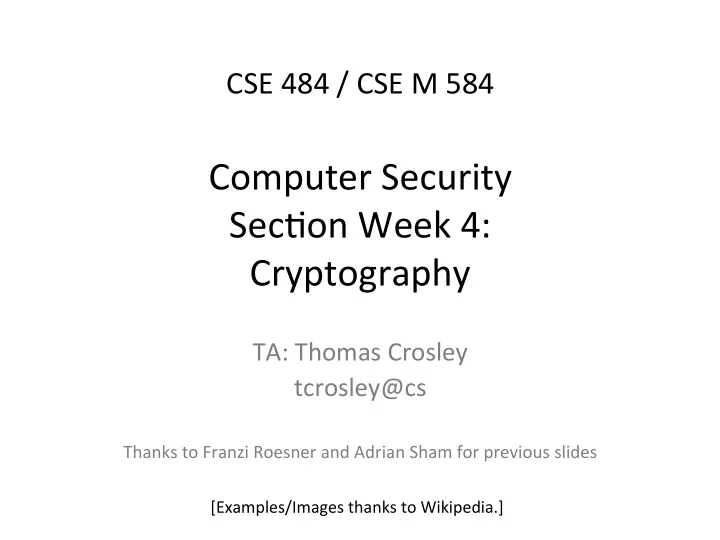

CSE 484 / CSE M 584 Computer Security Sec4on Week 4: Cryptography TA: Thomas Crosley tcrosley@cs Thanks to Franzi Roesner and Adrian Sham for previous slides [Examples/Images thanks to Wikipedia.]
Administrivia • Lab 1 Final due next week (Friday 4/29, 8pm) • Today – Fun Historical Ciphers – Crypto Review – Crypto Prac4ce – CBC-MAC Issue
Fun Historical Ciphers
Caesar Cipher (ShiY Cipher) • Plaintext leZers are replaced with leZers a fixed shiY away in the alphabet. • Example: – Plaintext: The quick brown fox jumps over the lazy dog. – Key: ShiY 3 ABCDEFGHIJKLMNOPQRSTUVWXYZ DEFGHIJKLMNOPQRSTUVWXYZABC – Ciphertext: WKHTX LFNEU RZQIR AMXPS VRYHU WKHOD CBGRJ
Caesar Cipher (ShiY Cipher) • ROT13: shiY 13 (encryp4on and decryp4on are symmetric) • What is the key space? – 26 possible shiYs. • How to aZack shiY ciphers? – Brute force.
Subs4tu4on Cipher • Superset of shiY ciphers: each leZer is subs4tuted for another one. • Monoalphabe4c subs4tu4on cipher: fixed subs4tu4on over the en4re message. • Example: – Plaintext: ABCDEFGHIJKLMNOPQRSTUVWXYZ – Cipher: ZEBRASCDFGHIJKLMNOPQTUVWXY
Subs4tu4on Cipher • What is the key space? 26! ~= 2^88 Bigrams: • How to aZack? th 1.52% en 0.55% ng 0.18% he 1.28% ed 0.53% of 0.16% – Frequency analysis. in 0.94% to 0.52% al 0.09% er 0.94% it 0.50% de 0.09% an 0.82% ou 0.50% se 0.08% re 0.68% ea 0.47% le 0.08% nd 0.63% hi 0.46% sa 0.06% at 0.59% is 0.46% si 0.05% on 0.57% or 0.43% ar 0.04% nt 0.56% ti 0.34% ve 0.04% ha 0.56% as 0.33% ra 0.04% es 0.56% te 0.27% ld 0.02% st 0.55% et 0.19% ur 0.02% Trigrams: 1. the 6. ion 11. nce 2. and 7. tio 12. edt 3. tha 8. for 13. tis 4. ent 9. nde 14. oft 5. ing 10. has 15. sth
Transposi4on Cipher • Ciphertext is permuta4on of plaintext. • Example: Route cipher – Plaintext: WE ARE DISCOVERED, FLEE AT ONCE – Arrangement: W R I O R F E O E E E S V E L A N J A D C E D E T C X – Key: “spiral inwards, clockwise, starting from top right” – Ciphertext: EJXCTEDECDAEWRIORFEONALEVSE
What is this? Scytale (used by ancient Greeks/Spartans) How is it used to do transposi4on? 1. Wrap 2. Write horizontally 3. Encrypt = unwrap 4. Decrypt = rewrap
Transposi4on/Subs4tu4on • How to tell if ciphertext was encrypted using subs4tu4on or transposi4on cipher? – If leZer frequencies are normal, it’s transposi4on. • What happens if you combine subs4tu4on and transposi4on? – Subs4tu4on prevents anagram finding, transposi4on prevents digram/trigram analysis.
Vigenère Cipher (~1467) • Polyalphabe4c subs4tu4on cipher: use mul4ple subs4tu4on alphabets. • Example: – Plaintext: ATTACKATDAWN – Key: LEMONLEMONLE – Ciphertext: LXFOPVEFRNHR • Encrypt: – (Key-Row, Msg-Col) – Or just addi4on mod 26
Vigenère Cipher (~1467) • Does this defeat frequency analysis? – Not if you know the length of the (repea4ng) key (e.g., if key length = 5, do frequency analysis on set of every 5 th leZer). – Even if you don’t know the key length, just iterate with length=1…n un4l decryp4on looks sensible. • What if the key doesn’t repeat (i.e., length of key >= length of plaintext) ? – One-4me pad. (Same caveats: fully random key, use only once…)
Enigma Machine Uses rotors (subs4tu4on cipher) that change posi4on aYer each key. Key = ini4al seqng of rotors Key space? 26^n for n rotors
Steganography • Hidden messages (security through obscurity) [Figure from “Hide and Seek: An Introduc4on to Steganography” by Niels Provos and Peter Honeyman]
Secret Messages in Video Games • Castle : program that encodes secret messages in video game communica4ons – Stony Brook University – Avoiding surveillance and firewalls in China – S4ll looks like a normal game from the outside • Encode: message -> player movements • Decode: player movements -> message Source: hZp://www.wired.com/2015/04/app-hides-secret-messages-starcraY-style-games/
Crypto Review
Flavors of Cryptography • Symmetric cryptography – Both communica4ng par4es have access to a shared random string K, called the key. • Asymmetric cryptography – Each party creates a public key pk and a secret key sk.
Achieving Privacy (Symmetric)
Achieving Privacy (Asymmetric)
Key exchange • Diffie-Hellman Key Agreement algorithm • RSA key exchange process (Next week!) hZps://technet.microsoY.com/en-us/library/cc962035.aspx
Achieving Integrity (Symmetric) • Message authen4ca4on schemes: A tool for protec4ng integrity. (Also called message authen4ca4on codes or MACs)
Achieving Integrity (Asymmetric) Digital signature schemes: A tool for protec4ng integrity and authen4city.
Pseudo Random Number Generator (PRNG) • Algorithm for genera4ng a sequence of numbers whose proper4es approximate the proper4es of sequences of random numbers. • In other word, sort of random, but not REALLY…
Crypto Prac4ce
Diffie-Helman Protocol • Alice and Bob never meet and share no secret • Public info: p and g – P is a large prime (public info) – G is a generator (public info) • Alice sends -> Bob g x mod p • Bob sends -> Alice g y mod p • k = (g x ) y = (g y ) x = g xy mod p (shared secret)
Diffie Helman Prac4ce Problem • P = 11 • G = 7 • Alice’s Private Key (x = 4) • Bob’s Private Key (y = 8) • What is their shared key?
Prac4ce Problem Solu4on • Alice computes 7 4 mod 11 = 3 • Bob computes 7 8 mod 11 = 9 • Shared secret is 3 8 = 9 4 mod 11 = 5
CBC-MAC Problem Integrity does not work here with variable length messages
CBC-MAC Problem BC(M xor O) = T BC(BC(M xor O) xor (M xor T)) = BC(T xor M xor T) = B(M) = T
Recommend
More recommend